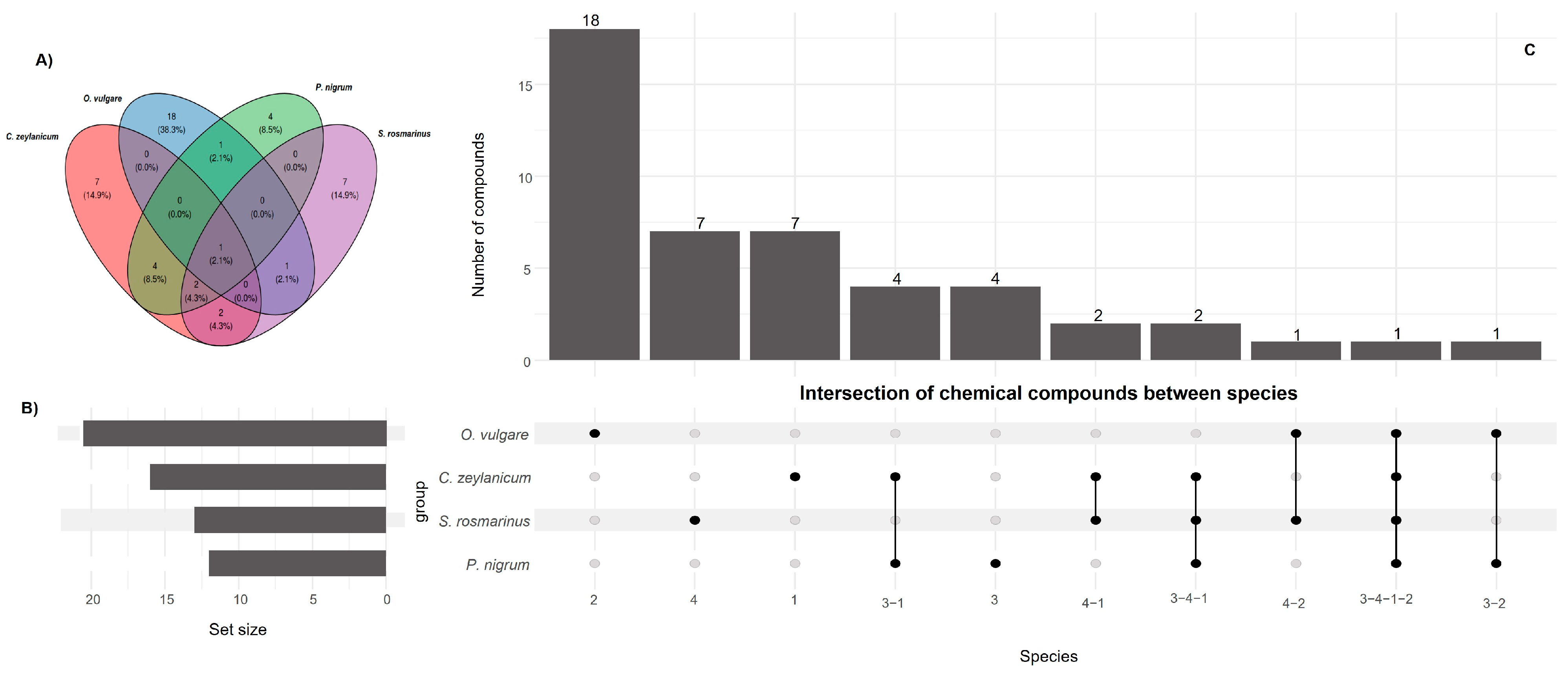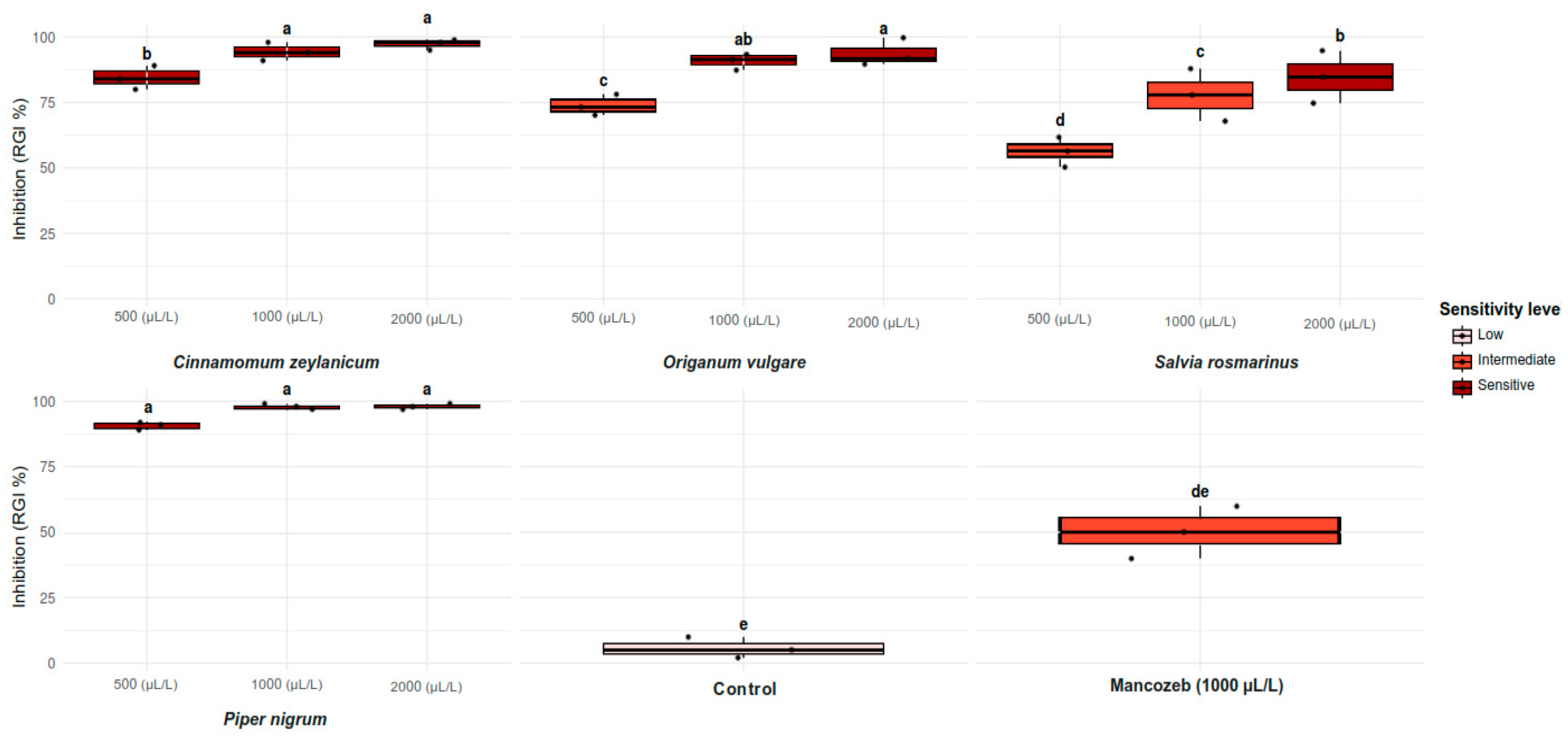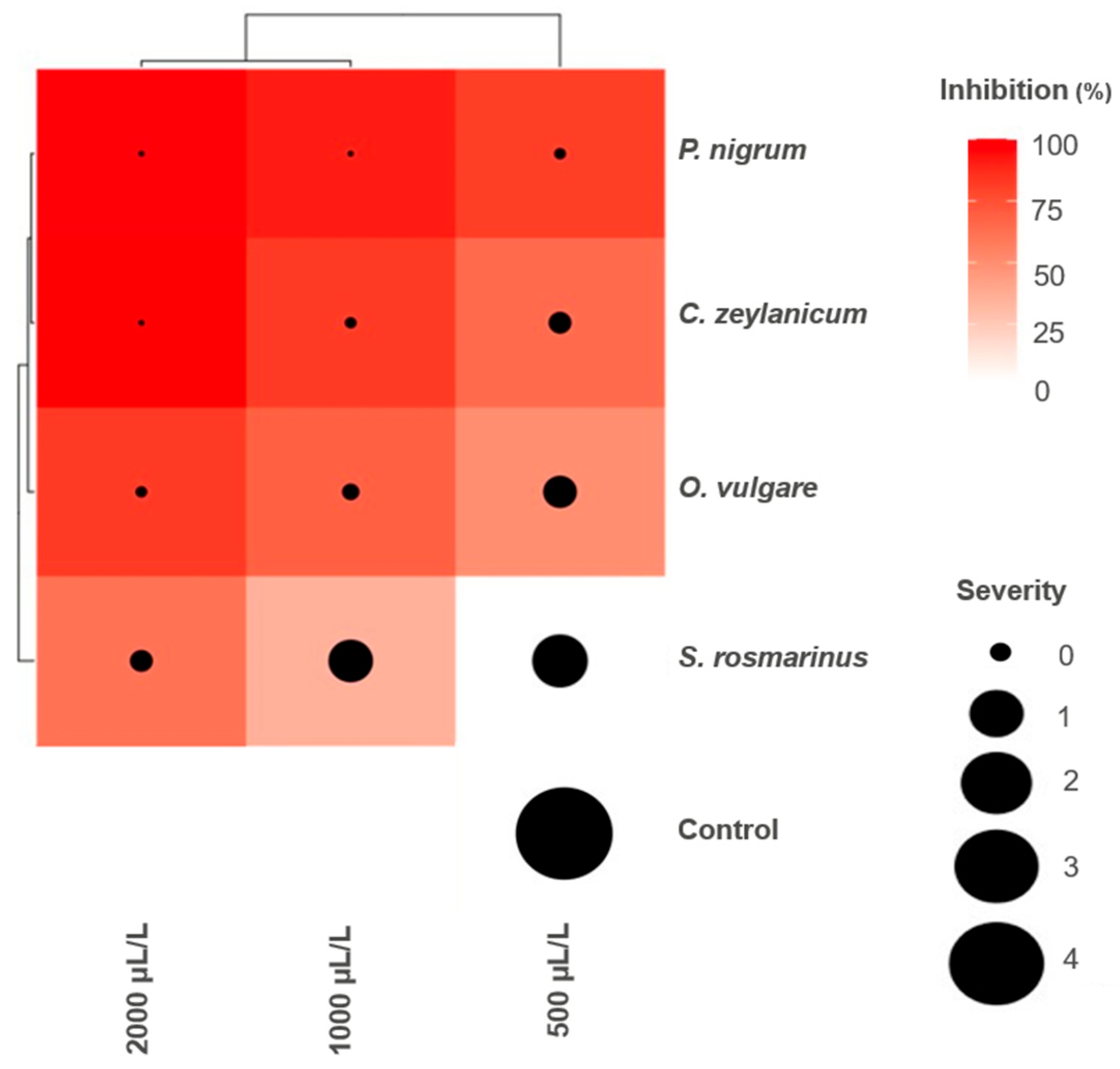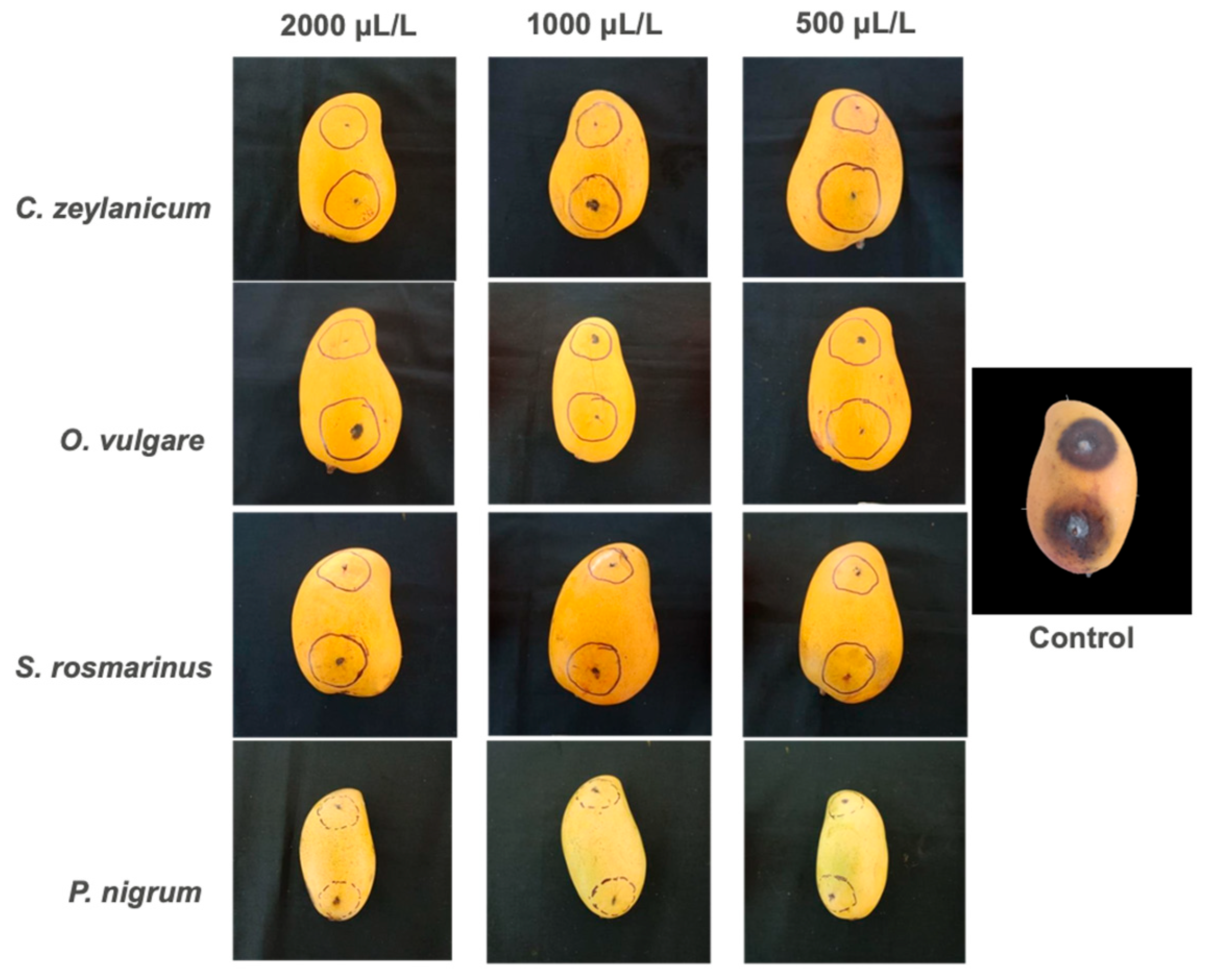Effect of Essential Oils on Postharvest Management of Anthracnose Associated with Colletotrichum gloeosporioides (Penz.) Penz & Sacc., in Mango
Abstract
1. Introduction
2. Results
2.1. EOs Analysis
2.2. Antifungal Tests
2.3. Fresh Fruit Severity Tests
3. Materials and Methods
3.1. Biological Material
3.2. Obtaining EOs
3.3. In Vitro Evaluation of Antifungal Activity
3.4. Fresh Fruit Severity Tests
3.5. Statistical Analysis
4. Conclusions
Supplementary Materials
Author Contributions
Funding
Data Availability Statement
Acknowledgments
Conflicts of Interest
References
- Food and Agriculture Organization. Available online: https://www.fao.org/faostat/en/#data/QCL (accessed on 20 July 2025).
- Servicio de Información Agroalimentaria y Pesquera. Estadísticas de Producción de Mango en México. Panorama Agroalimentario. Available online: https://www.gob.mx/siap (accessed on 8 July 2025).
- Le, T.D.; Viet Nguyen, T.; Muoi, N.V.; Toan, H.T.; Lan, N.M.; Pham, T.N. Supply chain management of Mango (Mangifera indica L.) fruit: A review with a focus on product quality during postharvest. Front. Sustain. Food Syst. 2022, 5, 799431. [Google Scholar] [CrossRef]
- Palacios, M.Y.P.; Llanos, G.A.H. Evaluación de tecnologías poscosecha de mango variedad Tommy Atkins en su calidad y vida útil. Prod. + Limpia 2023, 18, 38–61. [Google Scholar] [CrossRef]
- Ullah, M.A.; Khanal, A.; Joyce, P.; White, N.; Macnish, A.; Joyce, D. Internal Disorders of Mango Fruit and Their Management—Physiology, Biochemistry, and Role of Mineral Nutrients. Plants 2024, 13, 2596. [Google Scholar] [CrossRef]
- Wenneker, M.; Thomma, B.P. Latent postharvest pathogens of pome fruit and their management: From single measures to a systems intervention approach. Eur. J. Plant Pathol. 2020, 156, 663–681. [Google Scholar] [CrossRef]
- INIFAP (Instituto Nacional de Investigaciones Forestales, Agrícolas y Pecuarias). Estadísticas y Manejo de la Antracnosis en Mango; INIFAP: Mexico City, Mexico, 2023. [Google Scholar]
- Kumar, A.; Kudachikar, V.B. Antifungal properties of essential oils against anthracnose disease: A critical appraisal. J. Plant Dis. Prot. 2018, 125, 133–144. [Google Scholar] [CrossRef]
- Cuéllar-Torres, E.A.; Aguilera-Aguirre, S.; Hernández-Oñate, M.Á.; López-García, U.M.; Vega-Arreguín, J.; Montalvo-González, E.; Ostiz-Basurto, R.I.; Chacón-López, A. Molecular aspects revealed by omics technologies related to the defense system activation in fruits in response to elicitors: A review. Horticulturae 2023, 9, 558. [Google Scholar] [CrossRef]
- Kamle, M.; Kumar, P. Colletotrichum gloeosporioides: Pathogen of anthracnose disease in mango (Mangifera indica L.). In Current Trends in Plant Disease Diagnostics and Management Practices; Fungal Biology; Springer: Cham, Switzerland, 2016; pp. 207–219. [Google Scholar] [CrossRef]
- Peralta-Ruiz, Y.; Rossi, C.; Grande-Tovar, C.D.; Chaves-López, C. Green management of postharvest anthracnose caused by Colletotrichum gloeosporioides. J. Fungi 2023, 9, 623. [Google Scholar] [CrossRef]
- INIFAP (Instituto Nacional de Investigaciones Forestales, Agrícolas y Pecuarias). Informe Anual Sobre Enfermedades Poscosecha en Mango; INIFAP: Mexico City, Mexico, 2022. [Google Scholar]
- Dofuor, A.K.; Quartey, N. K-A.; Osabutey, A.F.; Antwi-Agyakwa, A.K.; Asante, K.; Boateng, B.O.; Ablormeti, F.K.; Lutuf, H.; Osei-Owusu, J.; Osei, J.H.N.; et al. Mango anthracnose disease: The current situation and direction for future research. Front. Microbiol. 2023, 14, 1168203. [Google Scholar] [CrossRef]
- Cortaga, C.Q.; Cordez, B.W.P.; Dacones, L.S.; Balendres, M.A.O.; Dela Cueva, F.M. Mutations associated with fungicide resistance in Colletotrichum species: A review. Phytoparasitica 2023, 51, 569–592. [Google Scholar] [CrossRef]
- Romero-Arenas, O.; Pérez-Vázquez, M.A.K.; Rivera, A.; Pacheco-Hernández, Y.; Ramírez-García, S.A.; Landeta-Cortés, G.; Villa-Ruano, N. Volatiles of Zanthoxylum limoncello as antifungal agents against the postharverst rot of manzano pepper triggered by Fusarium temperatum. Horticulturae 2022, 8, 700. [Google Scholar] [CrossRef]
- Chaudhari, A.K.; Singh, V.K.; Kedia, A.; Das, S.; Dubey, N.K. EOs and their bioactive compounds as eco-friendly novel green pesticides for management of storage insect pests: Prospects and retrospects. Environ. Sci. Pollut. Res. Int. 2021, 28, 18918–18940. [Google Scholar] [CrossRef] [PubMed]
- de Oliveira, T.S.; Costa, A.M.M.; Cabral, L.M.C.; Freitas-Silva, O.; Rosenthal, A.; Tonon, R.V. Anthracnose controlled by EOs: Are nanoemulsion-based films and coatings a viable and efficient technology for tropical fruit preservation? Foods 2023, 12, 279. [Google Scholar] [CrossRef]
- Almasaudi, N.M.; Al-Qurashi, A.D.; Elsayed, M.I.; Abo-Elyousr, K.A. EOs of oregano and cinnamon as an alternative method for control of gray mold disease of table grapes caused by Botrytis cinerea. J. Plant Pathol. 2022, 104, 317–328. [Google Scholar] [CrossRef]
- Buonsenso, F.; Schiavon, G.; Spadaro, D. Efficacy and mechanisms of action of EOs’ vapours against blue mould on apples caused by Penicillium expansum. Int. J. Mol. Sci. 2023, 24, 2900. [Google Scholar] [CrossRef]
- Ziedan, E.S.H.E.S. EOs a green fungicides for controlling postharvest diseases on banana fruits: A review. Analele Univ. Oradea Fasc. Biol. 2024, 31, 121–137. [Google Scholar]
- Coyotl-Pérez, W.A.; Rubio-Rosas, E.; Morales-Rabanales, Q.N.; Ramírez-García, S.A.; Pacheco-Hernández, Y.; Pérez-España, V.H.; Romero-Arenas, O.; Villa-Ruano, N. Improving the shelf life of avocado fruit against Clonostachys rosea with chitosan hybrid films containing thyme essential oil. Polymers 2022, 14, 2050. [Google Scholar] [CrossRef]
- Choudhary, H.; Dhar, V.; Dave, P.; Pareek, S. Postharvest anthracnose disease in mango (Mangifera indica L.) fruit: Sustainable alternatives for the control. Crop Sci. 2025, 65, e70064. [Google Scholar] [CrossRef]
- Danh, L.T.; Giao, B.T.; Duong, C.T.; Nga, N.T.T.; Tien, D.T.K.; Tuan, N.T.; Huong, B.T.C.; Nhan, T.C.; Trang, D.T.X. Use of essential oils for the controlo f anthracnose disease caused by Colletotrichum acutatum on post-harvest mangoes of Cat Hoa Loc variety. Membranes 2021, 11, 719. [Google Scholar] [CrossRef] [PubMed]
- Leesutthiphonchai, W.; Piasai, O.; Vajrodaya, S.; Umrung, S.; Schinnerl, J.; Steinkellner, S.; Khewkhom, N. Evaluation of efficacy of four Cinnamomum species extracts and cinnamaldehyde to control anthracnose of mango fruit. Eur. J. Plant Pathol. 2024, 170, 263–279. [Google Scholar] [CrossRef]
- Bilal, H.; Hashmi, M.S. Combination of rosemary oil and potassium sorbate controls anthracnose in mango fruit by triggering defense-related enzymes. Physiol. Mol. Plant Pathol. 2023, 127, 102112. [Google Scholar] [CrossRef]
- Sun, J.; Sun, P.; Kang, C.; Zhang, L.; Guo, L.; Kou, Y. Chemical composition and biological activities of EOs from six lamiaceae folk medicinal plants. Front. Plant Sci. 2022, 13, 919294. [Google Scholar] [CrossRef]
- Vilela, E.S.D.; Terao, D.; do Nascimento de Queiroz, S.C.; da Silva, A.M.; de Holanda Nunes Maia, A.; Fracarolli, J.A.; Dorta, C.; da Silva Dos Santos, L. Essential oils on the control of fungi causing postharvest diseases in mango. Braz. J. Microbiol. 2024, 55, 689–698. [Google Scholar] [CrossRef]
- Gertsch, J.; Leonti, M.; Raduner, S.; Racz, I.; Chen, J.Z.; Xie, X.Q.; Altmann, K.H.; Karsak, M.; Zimmer, A. Beta-caryophyllene is a dietary cannabinoid. Proc. Natl. Acad. Sci. USA 2008, 105, 9099–9104. [Google Scholar] [CrossRef] [PubMed]
- Zinno, P.; Guantario, B.; Lombardi, G.; Ranaldi, G.; Finamore, A.; Allegra, S.; Mammano, M.M.; Fascella, G.; Raffo, A.; Roselli, M. Chemical composition and biological activities of essential oils from Origanum vulgare genotypes belonging to the carvacrol and thymol chemotypes. Plants 2023, 12, 1344. [Google Scholar] [CrossRef] [PubMed]
- Valdivieso-Ugarte, M.; Gomez-Llorente, C.; Plaza-Díaz, J.; Gil, Á. Antimicrobial, antioxidant, and immunomodulatory properties of EOs: A systematic review. Nutrients 2019, 11, 2786. [Google Scholar] [CrossRef] [PubMed]
- Ogwaro, B.A.; O’Gara, E.A.; Hill, D.J.; Gibson, H. A study of the antimicrobial activity of combined black pepper and cinnamon EOs against Escherichia fergusonii in traditional African yoghurt. Foods 2021, 10, 2847. [Google Scholar] [CrossRef]
- Diniz do Nascimento, L.; Moraes, A.A.B.; Costa, K.S.D.; Pereira Galúcio, J.M.; Taube, P.S.; Costa, C.M.L.; Neves Cruz, J.; de Aguilar Andrade, E.H.; Faria, L.J.G. Bioactive natural compounds and antioxidant activity of EOs from spice plants: New findings and potential applications. Biomolecules 2020, 10, 988. [Google Scholar] [CrossRef]
- Cáceres-Guido, P.; Martín-Vázquez, N.; Ojeda-Sana, A.; Van Baren, C.; Balbarrey, Z.; Moreno, S. New synergistic combination therapy of mupirocin and α-pinene against multidrug-resistant clinical strains of methicillin-resistant Staphylococcus aureus. P. R. Health Sci. J. 2024, 43, 73–78. [Google Scholar]
- Blank, D.E.; Alves, G.H.; Freitag, R.A.; Corrêa, R.A.; Hübner, S.O.; Cleff, M.B. Chemical composition and cytotoxicity of Origanum vulgare L. and Rosmarinus officinalis L. Sci. Anim. Health 2016, 4, 117–130. [Google Scholar] [CrossRef]
- Madhumita, M.; Guha, P.; Nag, A. Extraction of betel leaves (Piper betle L.) essential oil and its bio-actives identification: Process optimization, GC-MS analysis and anti-microbial activity. Ind. Crop. Prod. 2019, 138, 111578. [Google Scholar] [CrossRef]
- Arunachalam, K.; Damazo, A.S.; Macho, A.; Lima, J.C.D.S.; Pavan, E.; Figueiredo, F.F.; Oliveira, D.M.; Cechinel-Filho, V.; Wagner, T.M.; Martins, D.T.O. Piper umbellatum L. (Piperaceae): Phytochemical profiles of the hydroethanolic leaf extract and intestinal anti-inflammatory mechanisms on 2,4,6 trinitrobenzene sulfonic acid induced ulcerative colitis in rats. J. Ethnopharmacol. 2020, 254, 112707. [Google Scholar] [CrossRef]
- Ekpenyong, C.E.; Akpan, E.E. Use of Cymbopogon citratus essential oil in food preservation: Recent advances and future perspectives. Crit. Rev. Food Sci. Nutr. 2017, 57, 2541–2559. [Google Scholar] [CrossRef]
- Batista, R.S.; Costa, H.; Alves, P.L.; de Oliveira, B.C.; de Abreu, K.M.P.; Menini, L. Essential oil of Piper macedoi Yunck. leaves, potential alternative for the management of banana anthracnose disease. J. Nat. Pest. Res. 2023, 5, 100039. [Google Scholar] [CrossRef]
- Lundgren, G.A.; Braga, S.D.P.; de Albuquerque, T.M.R.; Árabe Rimá de Oliveira, K.; Tavares, J.F.; Vieira, W.A.D.S.; Câmara, M.P.S.; de Souza, E.L. Antifungal effects of Conyza bonariensis (L.) Cronquist essential oil against pathogenic Colletotrichum musae and its incorporation in gum Arabic coating to reduce anthracnose development in banana during storage. J. Appl. Microbiol. 2022, 132, 547–561. [Google Scholar] [CrossRef]
- da Silva Vaz, P.D.; de Souza, W.R.N.; Wendland, A.; Paz, A.T.S.; Cortes, M.V.C.B.; Bara, M.T.F. Antifungal activity of Origanum vulgare and Rosmarinus officinalis phenolics-containing extracts against Colletotrichum lindemuthianum and in the suppression of anthracnose in common beans. Res. Soc. Dev. 2022, 11, e47911932145. [Google Scholar] [CrossRef]
- Nazzaro, F.; Fratianni, F.; Coppola, R.; de Feo, V. EOs and antifungal activity. Pharmaceuticals 2017, 10, 86. [Google Scholar] [CrossRef]
- Maqbool, M.; Ali, A.; Alderson, P.G.; Mohamed, M.T.M.; Siddiqui, Y.; Zahid, N. Postharvest application of gum arabic and EOs for controlling anthracnose and quality of banana and papaya during cold storage. Postharvest Biol. Technol. 2011, 62, 71–76. [Google Scholar] [CrossRef]
- Akdeniz, Y.; Kesimci, T.G. Chemical composition and biocontrol activity of different Essential oils against soil-borne fungal pathogens. Plant Pathol. J. 2024, 40, 192–204. [Google Scholar] [CrossRef] [PubMed]
- Fincheira, P.; Jofré, I.; Espinoza, J.; Levío-Raimán, M.; Tortella, G.; Oliveira, H.C.; Diez, M.C.; Quiroz, A.; Rubilar, O. The efficient activity of plant Essential oils for inhibiting Botrytis cinerea and Penicillium expansum: Mechanistic insights into antifungal activity. Microbiol. Res. 2023, 277, 127486. [Google Scholar] [CrossRef] [PubMed]
- Huang, X.; Liu, T.; Zhou, C.; Huang, Y.; Liu, X.; Yuan, H. Antifungal activity of essential oils from three Artemisia species against Colletotrichum gloeosporioides of mango. Antibiotics. 2021, 10, 1331. [Google Scholar] [CrossRef] [PubMed]
- Perumal, A.B.; Sellamuthu, P.S.; Nambiar, R.B.; Sadiku, E.R. Effects of essential oil vapour treatment on the postharvest disease control and different defence responses in two mango (Mangifera indica L.) cultivars. Food Bioprocess Technol. 2017, 10, 1131–1141. [Google Scholar] [CrossRef]
- Sukdee, S.; Ladpala, S.; Chayaowsakoon, P. Detecting the antifungal activity of the Piper genus against Colletotrichum capsici, the cause of chili anthracnose. J. Sci. Agric. Technol. 2024, 5, 1–6. [Google Scholar] [CrossRef]
- Tan, Y.; Nie, Y.; Yuan, X.; Yang, H.; Pan, Y.; Zhang, Z. Black pepper essential oil nanoemulsion inhibits Colletotrichum gloessential oilsporioides by regulating respiratory metabolism. Food Sci. Technol. 2024, 34, 687–697. [Google Scholar] [CrossRef]
- Velázquez, S.A.; Robles, Y.L.; Barrera, N.L.L. Chemical profile and antifungal activity of plant extracts on Colletotrichum spp. isolated from fruits of Pimenta dioica (L.) Merr. Pestic. Biochem. Physiol. 2021, 179, 104949. [Google Scholar] [CrossRef]
- Arango, B.O.; Hurtado, B.A.M.; Pantoja, D.D.; Santacruz, C.L. Antifungal activity of essential oil of Lippia origanoides H.B.K. on the growth of Phytophthora infestans. Acta Agron. 2015, 64, 116–124. [Google Scholar] [CrossRef]
- Ilag, P.; Sapali, S.N.; Shikalgar, N. Design, development and experimentation of distillation unit for essential oil. Mater. Today Proc. 2023, 72, 664–671. [Google Scholar] [CrossRef]
- Villa-Ruano, N.; Pacheco-Hernández, Y.; Zárate-Reyes, J.A.; Cruz-Durán, R.; Lozoya-Gloria, E. Volatile composition and biological activities of the leaf essential oil from Zanthoxylum limoncello grown in Oaxaca, México. Chem. Biodivers. 2019, 16, e1800498. [Google Scholar] [CrossRef]
- Azza, R.E.; Hala, M.I.; Sanaa, A.M. The role of storage on Mancozeb fungicide formulations and their antifungal activity against Fusarium oxysporium and Rhizoctonia solani. Arab. J. Chem. 2021, 14, 103322. [Google Scholar] [CrossRef]
- Akosah, Y.A.; Kostennikova, Z.S.; Lutfullin, M.T.; Lutfullina, G.F.; Afordoanyi, D.M.; Vologin, S.G.; Mardanova, A.M. Induced expression of CYP51a and HK1 genes associated with penconazole and fludioxonil resistance in the potato pathogen Fusarium oxysporum. Microorganisms 2023, 11, 1257. [Google Scholar] [CrossRef]
- Lombardo, M.F.; Panebianco, S.; Azzaro, A.; Catara, V.; Cirvilleri, G. Assessing copper-alternative products for the control of pre- and postharvest Citrus anthracnose. Plants 2023, 12, 904. [Google Scholar] [CrossRef]
- Corkidi, G.; Balderas-Ruíz, K.A.; Taboada, B.; Serrano-Carreón, L.; Galindo, E. Assessing mango anthracnose using a new three-dimensional image-analysis technique to quantify lesions on fruit. Plant Pathol. 2006, 55, 250–257. [Google Scholar] [CrossRef]






| KIC | RIL | Component | Class | Content of the Components (%) | |||
|---|---|---|---|---|---|---|---|
| P. nigrum | S. rosmarinus | C. zeylanicumm | O. vulgare | ||||
| 918 | 911 | Thujene | BM | - | - | - | 3.35 |
| 923 | 921 | α-Pinene | BM | 0.23 | 30.78 | 0.44 | 3.55 |
| 936 | 937 | Camphene | BM | - | 2.19 | - | - |
| 942 | 946 | 2,4-Thujadiene | BM | - | 1.12 | - | - |
| 965 | 958 | Benzaldehyde | ArM | - | - | 0.81 | - |
| 965 | 964 | β-Pinene | BM | - | - | - | 4.57 |
| 983 | 979 | 1-Octen-3-ol | AH | - | - | - | 3.77 |
| 992 | 992 | β-Myrcene | AM | 9.54 | 4.58 | - | 3.97 |
| 1011 | 1010 | 3-Carene | BM | - | - | - | 1.70 |
| 1021 | 1021 | p-Cymene | ArM | - | - | 0.49 | 3.72 |
| 1024 | 1028 | Limonene | MM | 0.57 | - | 0.72 | 1.24 |
| 1027 | 1029 | Eucalyptol | BM | 4.33 | 32.42 | 1.39 | --- |
| 1037 | 1037 | β-ocimene | AM | 0.75 | - | - | 1.89 |
| 1043 | 1041 | Benzyl alcohol | ArM | - | - | 14.44 | - |
| 1065 | 1064 | γ-Terpinene | MM | - | 1.93 | - | 4.61 |
| 1084 | 1088 | α-Terpinolene | MM | - | 1.35 | - | 2.77 |
| 1097 | 1096 | Sabinene hydrate | BM | - | - | - | 21.68 |
| 1101 | 1098 | Linalool | AM | 0.51 | 2.91 | 3.49 | - |
| 1137 | 1138 | Camphor | BM | - | 3.07 | 0.45 | - |
| 1164 | 1165 | Borneol | BM | - | 3.99 | - | - |
| 1162 | 1165 | Benzyl acetate | ArM | - | - | 1.64 | - |
| 1174 | 1177 | 4-Terpineol | MM | 0.48 | - | 0.53 | 3.44 |
| 1188 | 1190 | α-Terpineol | MM | - | - | - | 1.59 |
| 1201 | 1200 | Isocarveol | MM | 1.91 | - | - | - |
| 1202 | 1204 | Verbenone | BM | - | 7.04 | 1.55 | - |
| 1222 | 1228 | Thymol methyl ether | ArM | - | - | - | 4.62 |
| 1228 | 1232 | cis-Geraniol | AM | - | - | 0.41 | - |
| 1292 | 1291 | Terpinen-4-yl acetate | MM | - | - | - | 3.55 |
| 1235 | 1259 | E-Cinnamaldehyde | ArM | 0.34 | - | 2.97 | - |
| 1244 | 1262 | Isobornyl acetate | BM | - | 1.75 | - | - |
| 1298 | 1292 | Thymol | ArM | - | - | - | 1.89 |
| 1304 | 1302 | Carvacrol | ArM | - | - | - | 6.75 |
| 1360 | 1359 | Eugenol | ArM | 32.93 | - | 61.88 | - |
| 1405 | 1410 | Methyleugenol | ArM | 46.28 | - | - | - |
| 1427 | 1417 | β-Caryophyllene | BS | 0.82 | 2.05 | 0.68 | 2.46 |
| 1441 | 1444 | β-Cubebene | BS | - | - | - | 1.68 |
| 1449 | 1445 | Elemene | MS | - | - | - | 2.23 |
| 1784 | 1762 | Benzyl benzoate | ArM | - | - | 1.92 | -- |
| Total Aliphatic hydrocarbons (AH) | 3.77 | ||||||
| Total Aliphatic monoterpenes (AM) | 10.8 | 7.49 | 3.9 | 5.86 | |||
| Total Monocyclic monoterpenes (MM) | 2.96 | 3.28 | 1.25 | 17.2 | |||
| Total Bicyclic monoterpenes (BM) | 4.56 | 82.36 | 3.83 | 34.85 | |||
| Total Aromatic monoterpenes (ArM) | 79.55 | 84.15 | 16.98 | ||||
| Total Monocyclic sesquiterpenes (MS) | 2.23 | ||||||
| Total Bicyclic sesquiterpenes (BS) | 0.82 | 2.05 | 0.68 | 4.14 | |||
| Total compounds | 98.69 | 95.18 | 93.81 | 85.03 | |||
| Eos | Concentration (µL/L) | ||
|---|---|---|---|
| Cinnamomum zeylanicum | 500 | 1000 | 2000 |
| Origanum vulgare | |||
| Salvia rosmarinus | |||
| Piper nigrum | |||
| Control (Distilled water) | 500 µL/L | ||
| Mancozeb (C4H6MnN2S4) | 1000 µL/L | ||
| Classification | Sensitivity Level |
|---|---|
| Low (L) | <40% |
| Intermediate (I) | 40–75% |
| Sensitive (S) | >75% |
| Severity Index | Present in Fruit (%) | Description |
|---|---|---|
| 0 | 0 | Healthy |
| 1 | ≤25% | Traces (Chlorotic spots) |
| 2 | 26–50% | Light (Dark injuries 1 to 5 mm in diameter) |
| 3 | 51–75% | Moderate (Dark lesions greater than 6 mm in diameter) |
| 4 | >75% | Severe damage (Sunk dark injuries) |
Disclaimer/Publisher’s Note: The statements, opinions and data contained in all publications are solely those of the individual author(s) and contributor(s) and not of MDPI and/or the editor(s). MDPI and/or the editor(s) disclaim responsibility for any injury to people or property resulting from any ideas, methods, instructions or products referred to in the content. |
© 2025 by the authors. Licensee MDPI, Basel, Switzerland. This article is an open access article distributed under the terms and conditions of the Creative Commons Attribution (CC BY) license (https://creativecommons.org/licenses/by/4.0/).
Share and Cite
Andrade-Hoyos, P.; Hernández-Arenas, M.; Mendieta-Moctezuma, A.; Barrios-Gómez, E.J.; Romero-Arenas, O.; Ríos-Meléndez, S.; Parraguirre-Lezama, C.; Ibarra-Torres, P. Effect of Essential Oils on Postharvest Management of Anthracnose Associated with Colletotrichum gloeosporioides (Penz.) Penz & Sacc., in Mango. Plants 2025, 14, 3249. https://doi.org/10.3390/plants14213249
Andrade-Hoyos P, Hernández-Arenas M, Mendieta-Moctezuma A, Barrios-Gómez EJ, Romero-Arenas O, Ríos-Meléndez S, Parraguirre-Lezama C, Ibarra-Torres P. Effect of Essential Oils on Postharvest Management of Anthracnose Associated with Colletotrichum gloeosporioides (Penz.) Penz & Sacc., in Mango. Plants. 2025; 14(21):3249. https://doi.org/10.3390/plants14213249
Chicago/Turabian StyleAndrade-Hoyos, Petra, Marianguadalupe Hernández-Arenas, Aarón Mendieta-Moctezuma, Edwin Javier Barrios-Gómez, Omar Romero-Arenas, Selma Ríos-Meléndez, Conrado Parraguirre-Lezama, and Patricia Ibarra-Torres. 2025. "Effect of Essential Oils on Postharvest Management of Anthracnose Associated with Colletotrichum gloeosporioides (Penz.) Penz & Sacc., in Mango" Plants 14, no. 21: 3249. https://doi.org/10.3390/plants14213249
APA StyleAndrade-Hoyos, P., Hernández-Arenas, M., Mendieta-Moctezuma, A., Barrios-Gómez, E. J., Romero-Arenas, O., Ríos-Meléndez, S., Parraguirre-Lezama, C., & Ibarra-Torres, P. (2025). Effect of Essential Oils on Postharvest Management of Anthracnose Associated with Colletotrichum gloeosporioides (Penz.) Penz & Sacc., in Mango. Plants, 14(21), 3249. https://doi.org/10.3390/plants14213249







